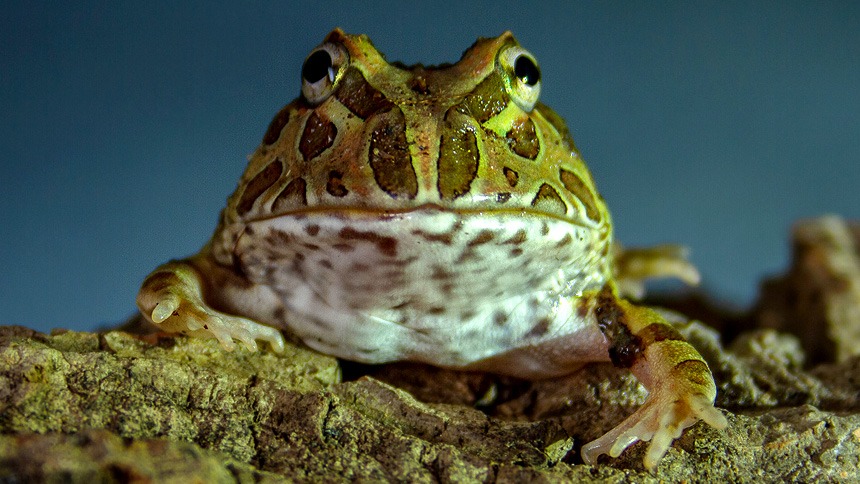
Pacman Frog Care Sheet & Pet Guide
Also known as South American Horned Frog (Ceratophrys)
Pacman Frogs are great for beginners and one of the most popular amphibians in the hobby. The main reasons for their popularity is due to their unique appearance and eating habits. They have a large mouth and insatiable appetite.
Hence the reason they’re so popular; they’re entertaining to watch.
Surprisingly, most beginners in the hobby don’t know how inexpensive it can be to keep one of these amazing frogs. Compared to other popular species, this one inexpensive and easy to care for.
Before we get into the pet care aspect of this page, it’s important to know a little information about the species. Notably, the common-name “Pac-Man Frog” actually represents 8 different species from the Ceratophrys genus. Each species is slightly different, noticeable mostly in colors and patterns.
Where their common name came from is a no-brainer; they look similar to the arcade-game character Pac-Man; especially while eating. They have large a mouth and a plump, round body.
Another interesting aspect about these frogs is their color morphs. As of writing this article, I was able to find at least 18 popular color morphs.
Listed below are some of the most popular morphs:
- Albino
- Mint green
- Strawberry
The maximum size of a Pacman Frog depends on the particular species. Some can grow to nearly 8 inches in length.
As for their lifespan, they can live up to 10 years or more. This species found a spot on our post about the best frogs for beginners. Check out that post if you’re on the fence about which frog to get first!
Page Contents
Pacman Frog Habitat Setup
Creating a Pacman Frog Habitat is easier than you might think. While they do get relatively big, they don’t utilize a lot of space. They’re ambush predators who lay and wait for their next meal. For this reason, they don’t require a large enclsoure.
A 12″ x 12″ x 12″ Exo Terra or Zoo Med terrarium will work nice. Something 18″ x 18″ x 18″ works too but you don’t need something that big. You can even use a 10-gallon aquarium! I currently have my son’s Pacman in a 10-gallon Aqueon tank I bought on sale for 50% off.
Here are some of the supplies you need:
- 10-gallon Terrarium
- Hygrometer/Thermometer (for checking humidity/temp)
- Coco-husk Substrate
- Water dish
- Heating Pad
- Thermostat
- Decoration for Hiding
- Live or fake plants
I think that list covers just about everything you need (except food, of course). Setting up their enclosure isn’t a monumental task. They will spend most of their time below the substrate anyway.
Make sure their substrate is 3 – 4 inches deep at least. So long as they can burrow without hitting bottom.
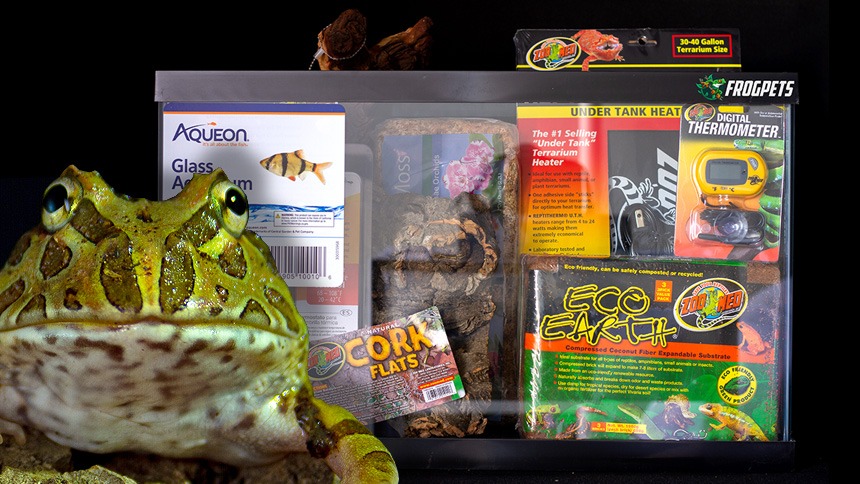
The habitat setup guide has a shopping list of all the items I used in creating that setup. Feel free to print off that list or simply click the links to find the items online.
Having said all this, you can get as crazy as you want. I’ve seen people build bioactive vivarium setups for their Pacman frog. It’s entirely up to you, so long as the basics are provided.
By the way, Pacman Frogs should not be kept together. They’re largely solitary creatures.
Lighting
These frogs are nocturnal, which means they’re more active at night. Not only that, it means they don’t require special lighting. They do, however, require a day and night schedule. If you’re keeping your frog in a room with little or no natural light from a window, then you need to provide lighting. A minimum of 12 hours of light each day is recommended.
One reason you might need special lighting is if you have live plants in the terrarium. Some plants require low-powered grow lights. Do some research on each plant’s requirements to see what exactly you need. Again, Pacman frogs don’t require special lighting, it’s only for live plants or to replicate a day and night schedule.
Temperature
The recommended temperature for Pacman frogs is between 75 – 85 degrees Fahrenheit; This temperature should be held during the day but at night-time, it can fall between 65 – 75 degrees Fahrenheit. The best way to check the temperature is by use of a thermometer. I recommend a digital thermometer hygrometer combo for checking to both temperature and humidity.
Unfortunately, this is just shy of what most consider “room temperature”. Pacman Frogs need a heater in order to get their enclosure to the recommended temperature range.
Out of the two, I would encourage you to try a reptile heat mat. Now, most of these heaters are designed to slide nicely under your terrarium but don’t do that. Instead, stick the heater on the side.
The reason I say this is because Pacman frogs like to burrow. While burrowing, it’s possible for them to get close enough to the heat mat to burn themselves. Since they spend most of their time burrowed into the substrate, it’s best not to disrupt this behavior.
Because you’re using a heating device, I recommend getting a thermostat to control the temperature.
By placing the heating pad on the side of the terrarium, you can create a nice temperature gradient from one side of the enclosure to the other. Not only that but if you add a nice pile of sphagnum moss on the side with the heater, it creates a “humid hide”.
Substrate
Pacman frogs are known for burrowing. They spend the majority of their time in the substrate, which is why it’s important to get this part right. Not only should the correct substrate be provided, it should also be slightly damp; your frog will benefit from the moisture.
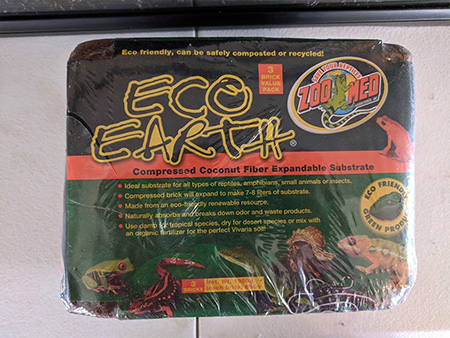
The most popular and common substrate used for Pacman Frogs is coco-husk fiber. Something like eco-earth or plantation soil is excellent. The substrate should be 3 – 4 inches deep.
One important part of the substrate is the moisture; it should remain moist at all times. This doesn’t mean it should be soggy. Don’t pour in a gallon of water and call it good. Coco-husk fiber is extremely good at retaining moisture but frequent mistings after the initial setup are required to keep it moist. Mist the enclosure as often as you need to keep the substrate moist, but not soggy.
Water Quality
As with all amphibians, clean water is essential. Due to their semi-permeable skin, chemicals like chlorine, fluoride, chloramine, ammonia, and other chemicals will have a harmful effect on them.
Tap-water is often the easiest way to provide water. It’s okay to use tap-water, so long as you treat it with a water conditioner like ReptiSafe. These agents remove chemicals and make the water safe for frogs.
Spring water is another great option but, compared to using a water conditioner, it gets expensive. Distilled water is fine for misting but should not be used as the main source of water because it lacks natural minerals.
Having said that, provide your Pacman Frog with a small, shallow water dish filled with clean water. The water should be deep enough for them to soak their skin but not so deep that they have to swim. You will need to change the water occasionally to keep it clean.
Humidity
Try to keep the humidity level somewhere between 60% – 70% as much as possible. Remember, they’re going to spend the majority of their time in the substrate; which should be moist at all times.
A misting system or fogger probably isn’t needed, unless you’re going on a trip or can’t seem to keep their enclosure’s humidity high enough. You may need to cover part of their enclosure with a piece of plastic or custom-cut glass to help increase the humidity in the terrarium.
One thing I do recommend is to create a “humid hide” by placing a large clump of sphagnum moss in the side of the tank where their heater is. Doing this gives your pet frog the option to move from one spot to another, should the humidity level be too much or not enough on either side of the terrarium.
Pacman Diet
A diet consisting of a variety of insects is recommended. They are ambush predators which feed on crickets, roaches, waxworms, mealworms, and the occasional pinky mice. In captivity, it’s hard for a Pacman frog to obtain all the nutrients they need from just crickets, roaches, and worms you find at the pet store.
Due to this, you should always gut-load and dust crickets with supplements before feeding them to your pet. Calcium is very important for healthy bones. I recommend dusting with a calcium supplement at least 2 – 3 times per week.
- Crickets
- Mealworms
- Waxworms
- Pinkie Mice
Once your Pacman Frog is big enough, they can eat pinkie mice. Try not to make common-practice of this. Yes, it’s fun to watch them eat. After all, this is why they are named after Pac-Man. But pinkie mice are high in fat and should only be used occasionally.
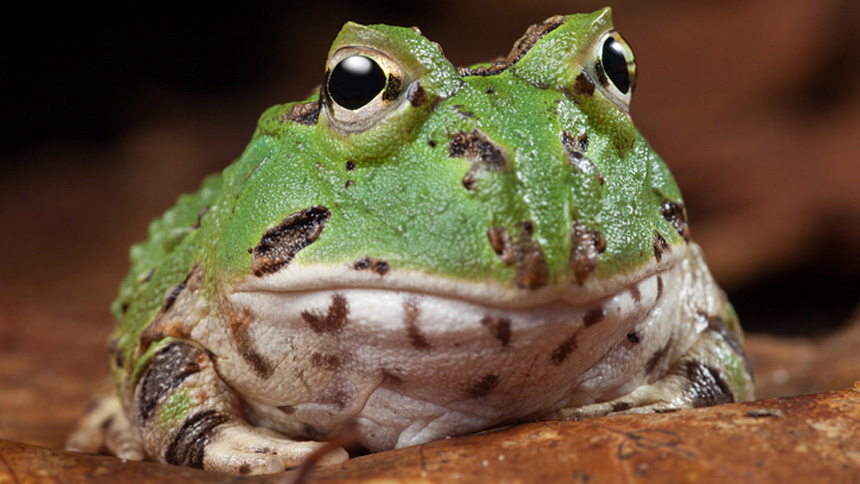
As for the number of insects you should feed them, it depends on their size and age. I recommend watching them eat and adjusting the amount of food based on how much they consume and by their overall appearance.
If they look too fat, cut back their food a little. If they’re too small, give them more food. Start by feeding them a few, appropriately sized crickets every other day. Make sure they’re getting plenty to eat but remove anything left over several hours after feeding.
Another important thing to note: These frogs can be cannibalistic. They’ve been known to eat their mates sometimes. So, this should go without saying but, keep your Pacman Frogs separated. Any prey up to half the size of your pet can easily fall victim. Sometimes they will attempt to swallow prey more than half their size, which can result in choking and death.
Breeding Pacman Frogs
Breeding Pacman Frogs can be a tricky task considering they can be cannibalistic. There is always the danger that you might lose a pet if you’re not careful. For this reason, you should always make sure your frogs are well-fed, especially before placing them in the breeding container.
In order to get your pets to breed, you’ll need to mimic the winter and springtime weather conditions. This isn’t as difficult as it sounds but it does require time and a clever breeding tank. Most people recommend a rain chamber while others opt for using a simple storage container with a shallow water bottom. Whatever you decide, it needs to be mostly water as the goal is to replicate a heavy, springtime rain.
Sexing
Determining whether or not you have both male and female frogs is the first step. This is relatively easy to do, especially with these species. A male is smaller in size and they have a black pad on their front legs, near their pads (fingers).
The pads are on the inside of their arms. Also, most males will croak or “chirp” while females usually will not. Females, on the other hand, are much larger than males. Often-times they’re twice the size, growing over 7 inches in length.
Mating
In order to get your frogs to breed, you’ll need to ‘cycle’ them. Cycling refers to a method of replicating their natural environment during the winter and spring seasons.
For 2 – 4 months you should mimic the winter months with temperatures around 60 degrees Fahrenheit. A shorter length of daylight hours will prove helpful as well. Maintain these conditions for at least 60 days.
Once you’ve finished the winter months, it’s time to replicate the springtime, which is breeding season. Raise the temperature back to normal or slightly above; somewhere around 80 degrees Fahrenheit. Ensure your Pacman frogs are very well fed before introducing them into the same enclosure.
It’s important to pay close attention to them and make sure they don’t try to eat each another. Place them together in a container with a rain chamber or full-water bottom. The water should be very shallow, allowing them to easily walk around.
With the rise in temperature, humidity, and increased water, your frogs should begin mating within a day. It’s important to ensure your frogs aren’t at risk of drowning. Give them a small land space and add an aquatic plant if possible.
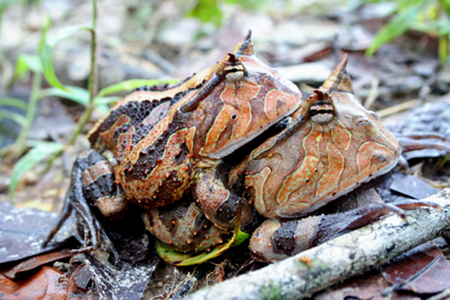
Should you be successful, you will likely find your pets in the amplexus position (pictures above). This is where the male grasps the female from behind. The female passes eggs through her cloaca and the male fertilized the eggs outside the body. The eggs will most likely be laid around the aquatic plant.
Once the eggs have been laid, you should separate the frogs back into their terrariums and continue caring for them like normal. The eggs will hatch in about 24 – 48 hours.
Tadpoles & Froglets
At this point, you will begin caring for the tadpoles. It’s important to remember, even the Ceratophrys tadpoles are cannibalistic. This is fine, actually, unless you’re determined to raise every single tadpole. If this is your goal, you should separate them individually. If not, I recommend separating them into several large groups so they’re easier to manage.
Do your best to keep the water temperature between 75 – 85 degrees Fahrenheit. Perform partial water changes as needed and, as always, make sure the water is clean and dechlorinated. Also, the water should be between 2 – 3 inches deep.
Feed the tadpoles a pinch of lettuce or cabbage each day. Other commercial tadpole foods will work as well. Only feed them what they will eat in 3 – 4 hours.
In roughly 30 days time, the tadpoles will metamorphose into small froglets. Once they begin developing their front legs, it’s time to add some land areas. Some keeper accomplishes this by simply tilting the container on one side, which creates a slanted land area on one side and water on the other.
Either way, a nice ramp will suffice. When their tails have completely disappeared, they can be moved to a normal terrarium. At this point, you can begin feeding them appropriately sized insects like pinhead crickets, fruit flies, etc.
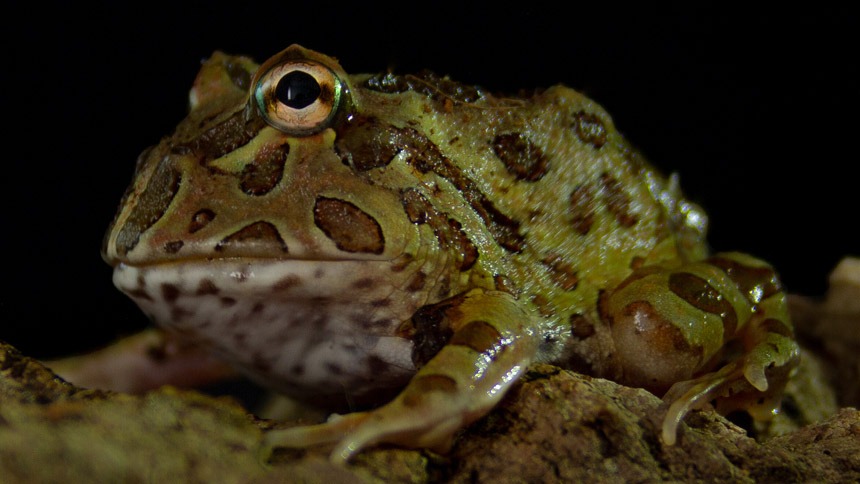
Handling Your Pacman Frog
Pacman Frogs will only tolerate the occasional handling. It’s best to just leave them alone as much as possible. As always, make sure you take the necessary safety precautions before holding them. Their skin is fragile. Toxins on your skin can be absorbed by your frog, which can potentially be harmful.
If you need to clean their enclosure or transfer them from one container to another, that’s fine. Clean your hands and leave them slightly damp before holding your frog or, if possible, wear non-powered vinyl gloves.
The main point is to make sure you don’t transfer any toxins from your hands to your frog. Be mindful of your frog’s temperament and try to avoid causing unwanted stress as much as possible.
Frequently Asked Questions
This section is meant to answer some of the most common questions regarding Pacman Frogs and keeping them in captivity.
No. In fact, most amphibians do not like being handles. Pacman Frog in particular are more aggressive than other frogs. It’s not uncommon for Pacman Frogs to bite, too. I’ve personally been dealt a swift bite on my finger while feeding mine. Regardless, no, they don’t want you to handle them.
Most amphibians don’t drink water in the same way humans do. Instead, they absorb water through their surroundings. They have semi-permeable skin that helps them stay submerged in water for long periods of time. They certainly need a water bowl to stay hydrated but they might not drink their water like other animals do.
Pacman Frogs don’t need to eat mice. In fact, feeding them mice too often could have a negative impact on their health. Only feed appropriately-sized mice to full-grown Pacman Frogs. Most hobbyists only use “pinky mice” because they’re small and less likely to cause problems for their pet. Moreover, do this sparingly.
Do not use earthworms from your back yard. They might contain parasites that your Pacman Frog is not adapted to handle. That rules applies to all feeder insects. Otherwise, yes, they can eat earthworms.
Frogs are ambush predators and rarely eat dead insects. Furthermore, Pacman Frogs in captivity actually need high-quality, nutrient-dense food sources because their captive diet doesn’t provide the variety of food sources they would have in the wild. Use healthy, live insects and consider supplementing with reptile vitamin powders.
Juvenile Pacman Frogs should not go more than two days without eating. They’re growing quickly and need high-quality foods to keep growing. If you choose to feed them crickets, ensure the crickets aren’t too big. They should fit into your frog’s mouth without a struggle. Feed 3 or 4 at a time and monitor how many are left over. See the diet guide in this post for more information regarding this topic.
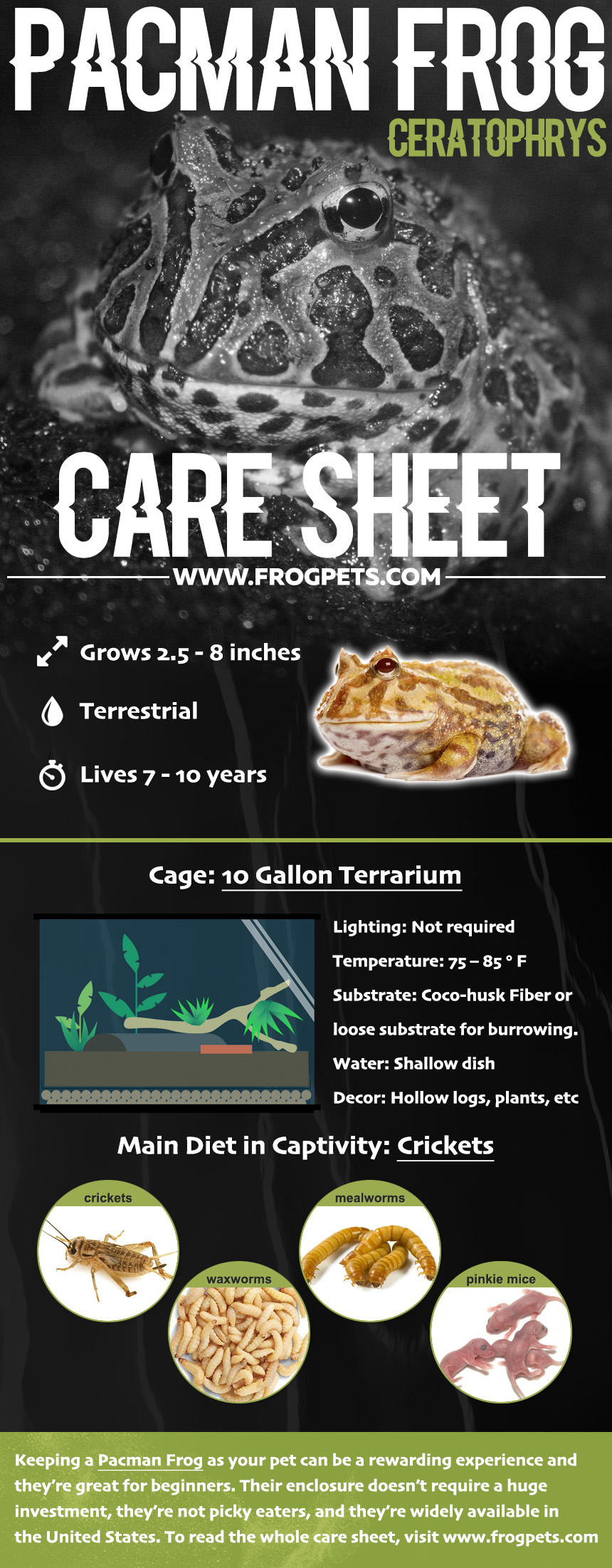
In the Wild
Ceratophrys can be found all over South America. From Venezuela to Colombia and Peru, and the surrounding areas. They’re found in tropical and subtropical grasslands, marshes, shrublands, lowland forests, ponds, and freshwater marshes.
They’re ambush predators, spending most of their time lying and waiting for prey to pass by them. Being nocturnal, they are mostly active at night.
Conclusion
Keeping Pacman Frogs as pets is an enjoyable experience. They have a neat appearance and they’re fun to watch, especially during feeding time. Caring for them isn’t hard once you know their basic needs.
Moreover, because they like to sit and wait for prey to walk by, you don’t need a huge enclosure. A 10 to 15 gallon tank is large enough for one. Mind you, Pacman Frogs are fairly aggressive towards other animals. They shouldn’t be housed together.

15 Comments
Yeah. Itll be fine. Digesting a bit of coco fiber doesnt hurt them. As for bumping their head on the wall, I doubt it could cause any serious energy but if there is a visible wound and it looks bad, you might want to take it to the vet
Hey there I’ve had my pacman about two months some time it’s color goes pale looking I’ve looked and temp and humidity are in normal range eating earth worm’s and feeder fish and cricket pretty good is there a reason for the color doing that
Hey, Terri! I apologize for the slow reply. It’s hard to say what’s causing that! It could be as simple as direct light or even the humidity within the enclosure. When this happens, does his/her whole body go pale? Mine likes to burrow a lot and when I see him out and about, his color seems different due to all the substrate on him. Looking forward to your reply.
Hi John! Thanks for the helpful article. Are Pacman frogs able to eat flightless fruit flies? I’ve been feeding mine crickets since I got him, and I wanted some more variation in his diet. Fluker’s recommended the fruit flies for frogs but I’m not sure if my Pacman will eat them. Thanks!
Hello, Ky! Good question. I’ve never tried feeding mine fruit flies because they’re so small. I don’t see why they wouldn’t eat fruit flies but I’d recommend something a little bigger. Here are a few ideas. Have you considered mealworms, waxworks, or dubia roaches? They’re all good options for a Pacman Frog!
Hey I just want to add regarding the day and night time cycle. You want to put your lights on an automatic timer so that their schedule stays consistent.
do pacman frogs need a drainage layer with the balls and mesh and then the substrate?
It’s not a requirement. You can, however, do a drainage layer if you want to. Just be sure to keep an eye on the substrate if you choose not to do the drainage layer. There shouldn’t be any stagnant/sitting water in the substrate.
Should the lid be solid glass or plastic or a screen?
Screen. Glass or plastic would trap in too much humidity!
Hey everyone! Im just a bit worried right now because my pacman frog kinda hit the aquarium glass and got some cocofiber on its mouth. Is it going to be okay?
i am having a trouble with keeping the temp not to hot when in the natural light as it gets to 100 f so i have to move his tank to other part of room due to i dont want to over heat him i am thinking of buying a light for him instead .
I’ve had that problem. Placing a tank near a window can be problematic in two ways. The light shining can heat the enclosure too much, primarily in the warmer months. If the window is drafty, it can make the enclosure too cold during the colder months.
In this article (very useful, by the way), you recommend having the frog in an area that gets 12 hours of natural sunlight. Does this need to be direct sunlight, or is indirect sunlight next to a window fine?
Hey, Matt! Sorry for the confusion. I just meant light in general (for the day-time hours). Creating a day and night cycle is important. So, for example, if you’re keeping your Pacman frog in a basement with no window, you’ll want to get a light for the enclosure to provide them with a day-time light. I hope that clarifies things. You don’t necessarily need to place their enclosure near a window for more natural light. You just need to be providing them with a proper day and night cycle; light during the day and dark during the night.